
Commercially attractive
 |
Multiple business modelsBroadcasters, audience and DTT operators can benefit from a variety of simple or mixed business models (Free to air, pay TV). Successful examples exist in Europe, with win-win mixed offers of free-to-air public service, free-to-air commercial service and pay-tv offers. |
|
 |
Right capacity for attractive contentWith the higher spectral efficiency offered by the latest modulation and coding schemes, it is possible to offer a variety of content and technical quality that is attractive to the Audience. Condition for success: An encouraging National Media Law, and a Reliable Audience measurement to evaluate take off and market share evolution. |
|
 |
Cost savingsDTT delivers consistent operational costs reduction due to digital multiplexing capabilities, all the expenses are in fact shared with the other programs in the multiplex. In addition, for broadcasters who own the national terrestrial transmission network, income might be generated from hosting other programmes. |
|
 |
Accessible premium contentDTT can offer premium content, like major sport events, at an accessible cost compared to satellite. Broadcasters will pay less due to coverage limited to national borders. Condition for success: A National Media Law supporting fair sports rights pricing and access. |
|
 |
EmploymentExtra local content can be provided thanks to the increased capacity with DTT and to a supportive DTT licensing regime. This content can be either produced by the Public Service Broadcasters or by local media providers. The National creative industry will benefit from support of Governments as it helps creating local jobs. |
Good for the country
 |
National sovereigntyDTT relies on the terrestrial distribution network which is bound and operated in the country. This characteristic allows the preservation of national sovereignty compared to extra-nationally controlled satellite platforms. |
|
 |
Content productionDTT enhances the creation of local content and local advertisement, it focuses on the national audience and it helps securing culture preservation and dissemination. |
Technically sound
 |
ResilientDTT is resilient to natural disaster, hacking attempts and weather conditions. For example satellite Ku Band, and even more Ka Band, signals are affected by heavy rainfalls, in some world regions, compromising the quality of service. |
|
 |
Spectrum stabilityDTT UHF spectrum is harmonised worldwide and benefits from certainty offered by WRC-15 and by the EU Decision on the future strategy for the UHF band. But pressure is still high (600 MHz in North America) and the subject will be open for discussion in WRC-23. A successful DTT platform is the best insurance against future attacks on spectrum. |
Mature and experienced
 |
International cooperationEuropean broadcasters and DTT stakeholders have experience in DTT business and operation. Depending on the specific issues that other broadcasters are facing, support can be identified and provided. In addition, ITU is fulfilling a valuable role in supporting transition to digital in different regions. |
EBU DTT Promotion and Monitoring
Although public broadcasters are available on pay-TV platforms such as satellite, cable and IPTV, Terrestrial Television (Analogue and DTT) remains the backbone to free-to-air TV access and the most widely used means of receiving television globally. Over 300 million households receive Analogue TV and nearly 200 million households receive DTT, of which around 120 million are in Europe. Despite its success, many countries around the world are yet to begin or complete the digital switchover process.
Given DTT’s unique social and economic opportunities, governments, broadcasters and other industry stakeholders should maximise their collaboration to accelerate the roll out of DTT.
To help promote the win-win scenario successful DTT offers, EBU, BNE and DVB have embarked on a process to share knowledge and bring DTT experts together to facilitate the introduction of successful DTT in countries still reliant on analogue TV.
Join us
If you are interested in DTT, contact us to participate in the discussions. Some restrictions may apply.
The following table gathers all relevant publications on DTT issued by the EBU, ITU, ECC and CEPT. For offline consulation click here for the downladable version.
| Document number | Title | ITU/WP | Approval date | Domain | Area | Source |
|---|---|---|---|---|---|---|
| BT.1871-1 | User requirements for wireless microphones | 6A | 17.06.2015 | SAB | System | ITU-R Recommendation |
| BT.1125-0 | Basic objectives for the planning and implementation of digital terrestrial television broadcasting systems | 6A | 01.07.1994 | DTV | System | ITU-R Recommendation |
| BT.1299-1 | The basic elements of a worldwide common family of systems for digital terrestrial television broadcasting | 6A | 01.03.2010 | DTV | System | ITU-R Recommendation |
| BT.798-1 | Digital terrestrial television broadcasting in the VHF/UHF bands | 6A | 01.07.1994 | DTV | System | ITU-R Recommendation |
| BT.1306-7 | Error correction, data framing, modulation and emission methods for digital terrestrial television broadcasting | 6A | 17.06.2015 | DTV | System | ITU-R Recommendation |
| BT.1774-2 | Use of satellite and terrestrial broadcast infrastructures for public warning, disaster mitigation and relief. Note - Identical to Rec. ITU-R BO.1774-1 | 6A | 14.10.2015 | DTV | System | ITU-R Recommendation |
| BT.1877-1 | Error-correction, data framing, modulation and emission methods for second generation of digital terrestrial television broadcasting systems | 6A | 01.08.2012 | DTV | System | ITU-R Recommendation |
| BT.2016-1 | Error-correction, data framing, modulation and emission methods for terrestrial multimedia broadcasting for mobile reception using handheld receivers in VHF/UHF bands | 6A | 22.01.2013 | DTV | System | ITU-R Recommendation |
| BT.2072-0 | Main functionalities of consumer receivers for worldwide broadcasting roaming | 6A | 04.02.2015 | DTV | System | ITU-R Recommendation |
| BT.1895-0 | Protection criteria for terrestrial broadcasting systems. Note - Identical to Recommendation ITU-R BS.1895 | 6A | 25.05.2011 | DTV | Protection | ITU-R Recommendation |
| BT.419-3 | Directivity and polarization discrimination of antennas in the reception of television broadcasting | 6A | 01.06.1990 | DTV | Planning | ITU-R Recommendation |
| BT.1368-13 | Planning criteria, including protection ratios, for digital terrestrial television services in the VHF/UHF bands | 6A | 01.06.2017 | DTV | Planning | ITU-R Recommendation |
| BT.2033-1 | Planning criteria, including protection ratios, for second generation of digital terrestrial television broadcasting systems in the VHF/UHF bands | 6A | 04.02.2015 | DTV | Planning | ITU-R Recommendation |
| BT.2036-1 | Characteristics of a reference receiving system for frequency planning of digital terrestrial television systems | 6A | 01.06.2016 | DTV | Planning | ITU-R Recommendation |
| BT.2052-1 | Planning criteria for terrestrial multimedia broadcasting for mobile reception using handheld receivers in VHF/UHF bands | 6A | 14.10.2015 | DTV | Planning | ITU-R Recommendation |
| BT.1195-1 | Transmitting antenna characteristics at VHF and UHF. Note - Identical to Rec. ITU-R BS.1195-1 | 6A | 22.01.2013 | DTV | Engineering | ITU-R Recommendation |
| BT.1206-3 | Spectrum limit masks for digital terrestrial television broadcasting | 6A | 01.05.2016 | DTV | Engineering | ITU-R Recommendation |
| BT.1893-1 | Assessment methods of impairment caused to digital television reception by wind turbines | 6A | 14.10.2015 | DTV | Engineering | ITU-R Recommendation |
| BT.1727-0 | Terrestrial and satellite delivery of programme material to large screen digital imagery venues | 6A (& 4B) | 08.04.2005 | DTV | System | ITU-R Recommendation |
| BT.2338-0 | Services ancillary to broadcasting/services ancillary to programme making spectrum use in Region 1 and the implication of a co-primary allocation for the mobile service in the frequency band 694-790 MHz | 6A | 2014 | SAB | Field | ITU-R Report |
| BT.2344-1 | Information on technical parameters, operational characteristics and deployment scenarios of SAB/SAP as utilized in broadcasting | 6A | 2016 | SAB | Field | ITU-R Report |
| BT.2295-1 | Digital terrestrial broadcasting systems | 6A | 2015 | DTV | System | ITU-R Report |
| BT.2139-0 | Diversity reception of digital terrestrial television broadcasting signals | 6A | 2008 | DTV | R&D | ITU-R Report |
| BT.2075-0 | Protection requirements for terrestrial television broadcasting services in the 620‑790 MHz band against potential interference from GSO and non-GSO broadcasting-satellite systems and networks | 6A | 2006 | DTV | Protection | ITU-R Report |
| BT.2247-3 | Field measurement and analysis of compatibility between DTTB and IMT | 6A | 2015 | DTV | Protection | ITU-R Report |
| BT.2265-1 | Guidelines for the assessment of interference into the broadcasting service | 6A | 2014 | DTV | Protection | ITU-R Report |
| BT.2296-0 | Example of application of Recommendation ITU-R BT.1895 and Report ITU-R BT.2265 to assess interference to the broadcasting service caused by the impact of IMT systems on existing head amplifiers of collective television distribution systems | 6A | 2013 | DTV | Protection | ITU-R Report |
| BT.2298-0 | Reference model to be used for the assessment of interference into the television broadcasting service in order to take into account non-linearity in the television radiofrequency receiving system | 6A | 2014 | DTV | Protection | ITU-R Report |
| BT.2337-0 | Sharing and compatibility studies between digital terrestrial television broadcasting and terrestrial mobile broadband applications, including IMT, in the frequency band 470-694/698 MHz | 6A | 2014 | DTV | Protection | ITU-R Report |
| BT.2339-0 | Co-channel sharing and compatibility studies between digital terrestrial television broadcasting and international mobile telecommunication in the frequency band 694-790 MHz in the GE06 planning area | 6A | 2014 | DTV | Protection | ITU-R Report |
| BT.2382-1 | Description of interference into a DTT receiver | 6A | 2016 | DTV | Protection | ITU-R Report |
| BT.2383-1 | Characteristics of DTTB systems in the frequency band 470-862 MHz for frequency sharing/interference analyses | 6A | 2016 | DTV | Protection | ITU-R Report |
| BT.2137-0 | Coverage prediction methods and planning software for digital terrestrial television broadcasting (DTTB) networks | 6A | 2008 | DTV | Planning | ITU-R Report |
| BT.2209-1 | Calculation model for SFN reception and reference receiver characteristics of ISDB-T system | 6A | 2013 | DTV | Planning | ITU-R Report |
| BT.2254-3 | Frequency and network planning aspects of DVB-T2 | 6A | 2017 | DTV | Planning | ITU-R Report |
| BT.2248-0 | A conceptual method for the representation of loss of broadcast coverage | 6A | 2011 | DTV | Planning | ITU-R Report |
| BT.2140-9 | Transition from analogue to digital terrestrial broadcasting | 6A | 2015 | DTV | Field | ITU-R Report |
| BT.2343-2 | Collection of field trials of UHDTV over DTT networks | 6A | 2016 | DTV | Field | ITU-R Report |
| BT.2301-2 | National field reports on the introduction of IMT in the bands with co-primary allocation to the broadcasting and the mobile services | 6A | 2016 | DTV | Field | ITU-R Report |
| BT.2302-0 | Spectrum requirements for terrestrial television broadcasting in the UHF frequency band in Region 1 and the Islamic Republic of Iran | 6A | 2014 | DTV | Field | ITU-R Report |
| BT.2387-0 | Spectrum / frequency requirements for bands allocated to broadcasting on a primary basis | 6A | 2015 | DTV | Field | ITU-R Report |
| BT.2299-2 | Broadcasting for public warning, disaster mitigation and relief | 6A | 2017 | DTV | Field | ITU-R Report |
| BT.2035-2 | Guidelines and techniques for the evaluation of digital terrestrial television broadcasting systems including assessment of their coverage areas | 6A | 2008 | DTV | Evaluation | ITU-R Report |
| BT.2143-2 | Boundary coverage assessment of digital terrestrial television broadcasting signals | 6A | 2010 | DTV | Evaluation | ITU-R Report |
| BT.2215-6 | Measurement of protection ratios and overload thresholds for broadcast TV receivers | 6A | 2016 | DTV | Evaluation | ITU-R Report |
| BT.2252-3 | Objective quality coverage assessment of digital terrestrial television broadcasting signals of Systems A and B | 6A | 2017 | DTV | Evaluation | ITU-R Report |
| BT.482-1 | Recommended characteristics for collective and individual antenna systems for domestic reception of signals from terrestrial transmitters | 6A | 1986 | DTV | Engineering | ITU-R Report |
| BT.2138-0 | Radiation pattern characteristics of UHF television receiving antennas | 6A | 2008 | DTV | Engineering | ITU-R Report |
| BT.2253-0 | GPS timing receivers for DVB-T SFN application: 10 MHz phase recovery | 6A | 2012 | DTV | Engineering | ITU-R Report |
| BT.2294-0 | Construction technique of DTTB relay station network for ISDB-T | 6A | 2013 | DTV | Engineering | ITU-R Report |
| BT.2385-0 | Reducing the environmental impact of terrestrial broadcasting systems | 6A | 2015 | DTV | Engineering | ITU-R Report |
| BT.2386-0 | Digital Terrestrial Broadcasting: Design and implementation of single frequency networks (SFN) | 6A | 2015 | DTV | Engineering | ITU-R Report |
| BT.2142-2 | The effect of the scattering of digital television signals from a wind turbine | 6A | 2015 | DTV | Engineering | ITU-R Report |
| BT.2384-0 | Implementation considerations for the introduction and transition to digital terrestrial sound and multimedia broadcasting | 6A | 2015 | DTV - DSB | Planning | ITU-R Report |
| BT.2053-2 | Large screen digital imagery | 6A/B/C | 2009 | DTV | System | ITU-R Report |
| R-HDB-39 | DTTB Handbook - Digital terrestrial television broadcasting in the VHF/UHF bands | 6A | 2012 | DTV | Planning and implementation | ITU-R Handbook |
| R-HDB-63 | Handbook on Digital Terrestrial Television Broadcasting networks and systems implementation | 6A | 2016 | DTV | Planning and implementation | ITU-R Handbook |
| EBU Tech 3344 | Guidelines for distribution and reproduction in accordance with R 128 | N/A | 25 Jul 2016 | DTV, DSB | QoS | EBU |
| EBU Tech 3343 | Practical guidelines for EBU R128 (Loudness) | N/A | 25.01.2016 | DTV, DSB | QoS | EBU |
| EBU Tech 3342 | Loudness range: A measure to supplement EBU R 128 loudness normalisation | N/A | 25.01.2016 | DTV, DSB | QoS | EBU |
| EBU Tech 3341 | EBU Mode' metering to supplement EBU R 128 loudness normalisation | N/A | 25.01.2016 | DTV, DSB | QoS | EBU |
| EBU Tech 3348 | Frequency & Network Planning Aspects of DVB T2 | N/A | 29.10.2014 | DTV | Planning | EBU |
| EBU Tech 3335 | Measurements of TV cameras for Characterising & Setting | N/A | 19 Aug 2014 | DTV | Production | EBU |
| EBU Tech 3359 | Media Storage Demands | N/A | 18 Jun 2014 | DTV, DSB | Production | EBU |
| EBU Tech 3362 | Media Storage; Design & Benchmarking | N/A | 27 Aug 2013 | DTV, DSB | Production | EBU |
| EBU Tech 3338 | Requirements for HBB TV Systems & Services | N/A | 14.10.2010 | DTV | Distribution | EBU |
| EBU Tech 3299 | High Definition (HD) Image Formats for Television Production | N/A | 22.01.2010 | DTV | Production | EBU |
| Tech Report 038 | Subjective evaluation of HLG for HDR and SDR distribution | N/A | 30.03.2017 | DTV | Production | EBU |
| Tech Report 037 | Video System Requirements for UHDTV and an Advanced 1080p TV Format | N/A | 06 Jul 2016 | DTV | Production | EBU |
| Tech Report 036 | HEVC coded (U)HDTV in DVB-T2 | N/A | 18.03.2016 | DTV | Distribution | EBU |
| Tech Report 035 | An Introduction To Time-Frequency Slicing | N/A | 03.03.2016 | DTV | Distribution | EBU |
| Tech Report 034 | Simulation parameters for theoretical LTE eMBMS Network Studies | N/A | 22 Dec 2015 | DTV | Distribution | EBU |
| Tech Report 028 | EBU Policy Statement on UHDTV | N/A | 21 Jul 2015 | DTV | Production | EBU |
| Tech Report 031 | Sustainable production - Practical Steps to Implementation | N/A | 20.11.2014 | DTV - DSB | Production | EBU |
| Tech Report 029 | DVB-T2 SFN Spectrum Efficiency | N/A | 17.11.2014 | DTV | Distribution | EBU |
| Tech Report 027 | Delivery of Broadcast Content over LTE Networks | N/A | 31 Jul 2014 | DTV | Distribution | EBU |
| Tech Report 024 | Planning and Implementation for T-DAB and DVB-T | N/A | 18.10.2013 | DTV - DSB | Distribution | EBU |
| Tech Report 022 | Terrestrial Digital Television Planning Considerations | N/A | 18.10.2013 | DTV | Distribution | EBU |
| Tech Report 016 | Benefits and Limitations of SFNs for DTT | N/A | 10.10.2012 | DTV | Distribution | EBU |
| Tech Review 2017 | Cost-benefit analysis of FM, DAB, DAB+ and broadband for radio broadcasters and listeners | N/A | 31 Jul 2017 | DSB | Distribution | EBU |
| Tech Review 2017 | DAB+ Signal Propagation in Tunnels | N/A | 10.03.2017 | DSB | Engineering | EBU |
| Tech Review 2017 | WiB - A New System Concept for DTT | N/A | 06.03.2017 | DTV | Distribution | EBU |
| Tech Review 2015 | TLCI-2012 News | N/A | 24 Feb 2015 | DTV | Production | EBU |
| Tech Review 2014 | TV Distribution via Cellular Networks Part 2: Costs | N/A | 21 May 2014 | DTV | Distribution | EBU |
| Tech Review 2014 | TV Distribution via Cellular Networks Part 1: Spectrum | N/A | 21 May 2014 | DTV | Distribution | EBU |
| Tech Review 2014 | Crystal ball, tea leaves or maths - forecasting data traffic for IMT | N/A | 25.03.2014 | DTV | Spectrum | EBU |
| Tech Review 2013 | DTT Quo Vadis - Germany as a case study | N/A | 15.03.2013 | DTV | Distribution | EBU |
| Tech Review 2013 | The future role of Broadcasting | N/A | 28.01.2013 | DTV | Distribution | EBU |
| Tech Review 2012 | Loudness - don't forget the distribution chain! | N/A | 24.09.2012 | DTV | QoS | EBU |
| Tech Review 2012 | DAB Norway - Implementation of loudness normalization | N/A | 22.03.2012 | DSB | QoS | EBU |
| Tech Review abbreviations | EBU Technical Review abbreviations | N/A | 09.01.2012 | - | - | EBU |
| Tech Review 2011 | How can mobile and broadcasting networks use adjacent bands? | N/A | 26.01.2011 | DTV | Sharing | EBU |
| Tech Review 2010 | On the way to Loudness Nirvana - with EBU R 128 | N/A | 06.09.2010 | DTV | QoS | EBU |
| Tech Review 2010 | HbbTV— a hybrid broadcast-broadband system for the living room | N/A | 01.03.2010 | DTV | Distribution | EBU |
| EBU Fact Sheet | Relevance of FTA distribution for PSM | N/A | 26.10.2017 | DTV - DSB | Distribution | EBU |
| EBU Fact Sheet | PSM Requirements in Distribution | N/A | 02.10.2017 | DTV - DSB | Distribution | EBU |
| Tech Fact Sheet | Video Monitors | N/A | 29.09.2017 | DTV | Production | EBU |
| Tech Fact Sheet | Quality Control (QC) | N/A | 26.09.2017 | DTV - DSB | QoS | EBU |
| Tech Fact Sheet | SFN myths and Realities | N/A | 01.09.2017 | DTV - DSB | Distribution | EBU |
| Tech Fact Sheet | PPDR in adjacent bands to DTT | N/A | 06.03.2017 | DTV | Sharing | EBU |
| Tech Fact Sheet | Loudness | N/A | 26.01.2016 | DTV | QoS | EBU |
| Tech Fact Sheet | WRC-15 results | N/A | 08.12.2015 | DTV | Spectrum | EBU |
| Tech Fact Sheet | Quality Control | N/A | 01.09.2015 | DTV - DSB | QoS | EBU |
| EBU Fact Sheet | Can LTE share spectrum with DTT? | N/A | 24 Aug 2015 | DTV | Spectrum | EBU |
| EBU Fact Sheet | Protection of DTT from LTE 700 | N/A | 26 Feb 2015 | DTV | Sharing | EBU |
| EBU Fact Sheet | PSM Requirements in Distribution | N/A | 19 Dec 2014 | DTV - DSB | Distribution | EBU |
| Tech Fact Sheet | EBU UHD test material | N/A | 22.09.2014 | DTV | Production | EBU |
| Tech Fact Sheet | White Space Devices | N/A | 22.09.2014 | DTV | Sharing | EBU |
| Tech Fact Sheet | Use of Band III | N/A | 22.09.2014 | DTV - DSB | Spectrum | EBU |
| Tech Fact Sheet | High Efficiency Lighting | N/A | 19.09.2014 | DTV | Production | EBU |
| Tech Fact Sheet | Media Delivery Strategies | N/A | 17.09.2014 | DTV - DSB | Distribution | EBU |
| Tech Fact Sheet | TV Distribution Platforms | N/A | 17.09.2014 | DTV | Distribution | EBU |
| Tech Fact Sheet | LED Lighting Interference - Good Installation Practice | N/A | 28 May 2014 | - | Protection | EBU |
| CEPT Report 060 | Harmonised technical conditions for the 694 -790 MHz band | N/A | 02.03.2016 | - | Sharing | CEPT |
| CEPT Report 053 | Harmonised technical conditions for the 694 -790 MHz band | N/A | 28.11.2014 | - | Sharing | CEPT |
| CEPT Report 032 | Continuation of PMSE operating in the UHF, including the assessment of the advantage of an EU approach | N/A | 30.10.2009 | PMSE | Spectrum | CEPT |
| CEPT Report 031 | Frequency (channelling) arrangements for the 790-862 MHz band". (Task 2 of the 2nd Mandate to CEPT on the digital dividend) | N/A | 30.10.2009 | - | Sharing | CEPT |
| CEPT Report 030 | The identification of common and minimal (least restrictive) technical conditions for 790 - 862 MHz for the digital dividend in the European Union | N/A | 30.10.2009 | - | Sharing | CEPT |
| ECC Report 240 | Studies for BB PPDR and other applications in 410-430 and 450-470 MHz and adjacent bands | N/A | 30.09.2015 | DTV | Sharing | ECC |
| ECC Report 239 | Studies for BB PPDR systems in the 700 MHz range | N/A | 30.09.2015 | DTV | Sharing | ECC |
| ECC Report 236 | Guidance for national implementation of a regulatory framework for TV WSD using geo-location database | N/A | 27.05.2015 | DTV | Sharing | ECC |
| ECC Report 224 | Long Term Vision for the UHF broadcasting band | N/A | 28.11.2014 | DTV | Spectrum | ECC |
| ECC Report 221 | Adjacent band compatibility between MFCN and PMSE audio applications in the 700 MHz frequency band | N/A | 18.09.2014 | - | Sharing | ECC |
| ECC Report 186 | Technical and operational requirements for WSD under geo-location approach | N/A | 29.01.2013 | DTV | Sharing | ECC |
| ECC Report 185 | Definition of technical and operational requirements for WSD in 470-790 MHz | N/A | 29.01.2013 | DTV | Sharing | ECC |
| ECC Report 159 | Cognitive radio systems in the 'white spaces' in 470-790 MHz | N/A | 03.02.2011 | DTV | Sharing | ECC |
| ECC Report 116 | Converting GE06 DVB-T allotments/assignments in Band III into T-DAB allotments/assignments | N/A | 25.02.2008 | DTV | Spectrum | ECC |
EBU Members can download the DTT Implementation Status database (.xlsx file, 17MB, published 08.11.2023), used to generate the tables and charts below. Several additional tables and charts are available within the database.
An updated version of the table is published every 5–6 months.
DTT Implementation Overview
DTT is the main distribution platform for TV content with ever-growing number of countries launching services.
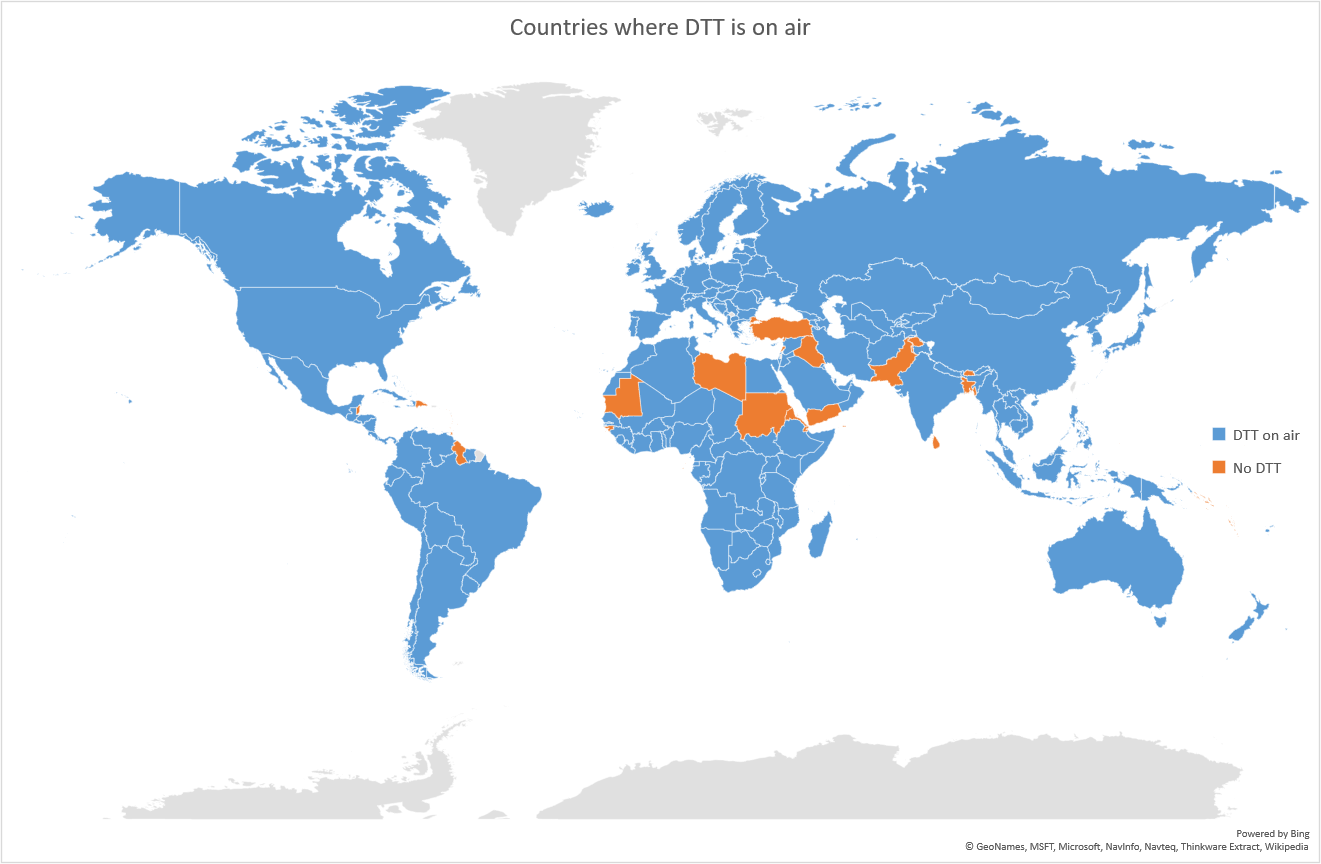 |
Analogue switch-off (ASO) has been completed in 49% of the world's countries, which together are home to 62% of the world's population; an additional 8% of countries have set a date for ASO. In 43% of countries there is no formal date for ASO; those countries account for 26.8% of the world's population.

The map below shows the countries where ASO has been completed.
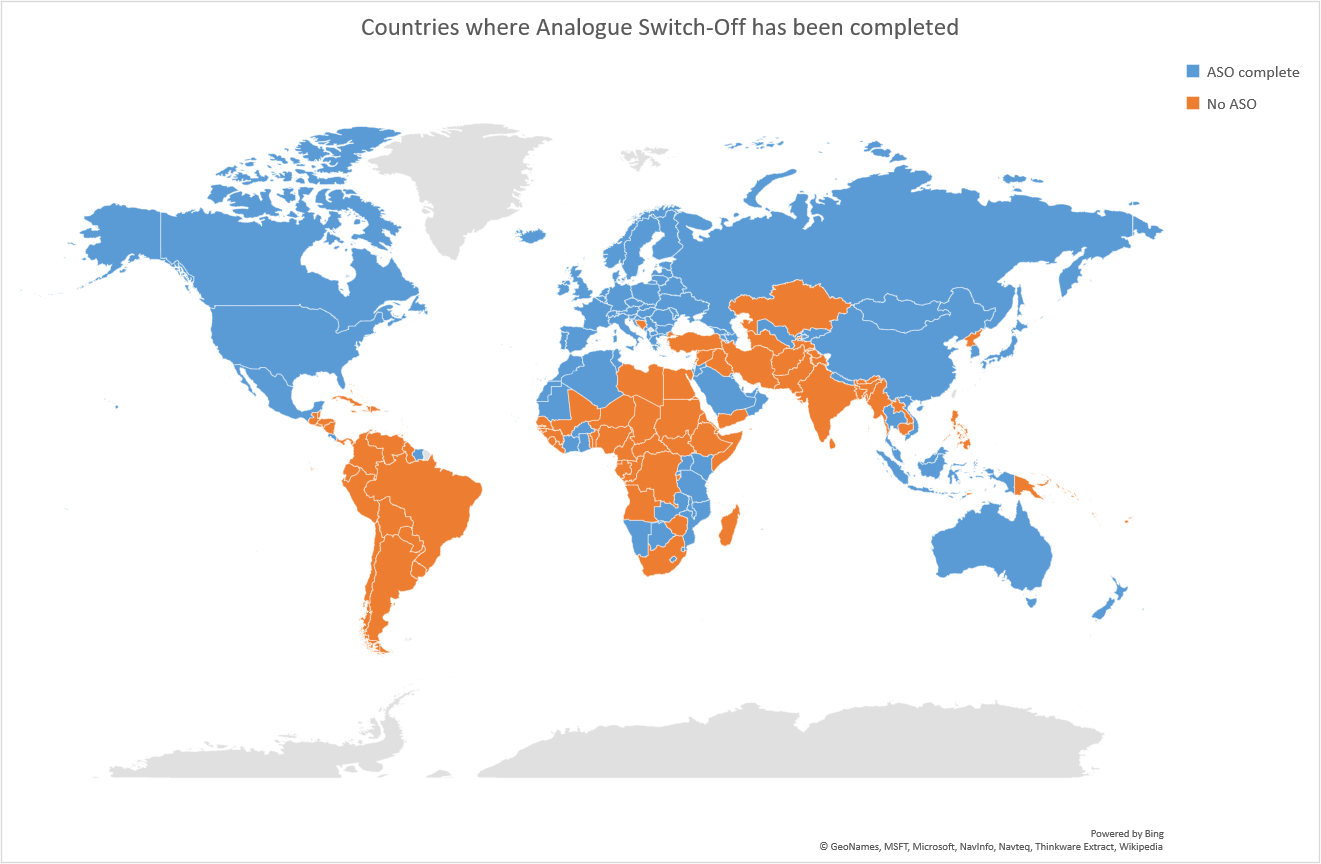 |
Eight countries planned to complete analogue switch-off during 2023.
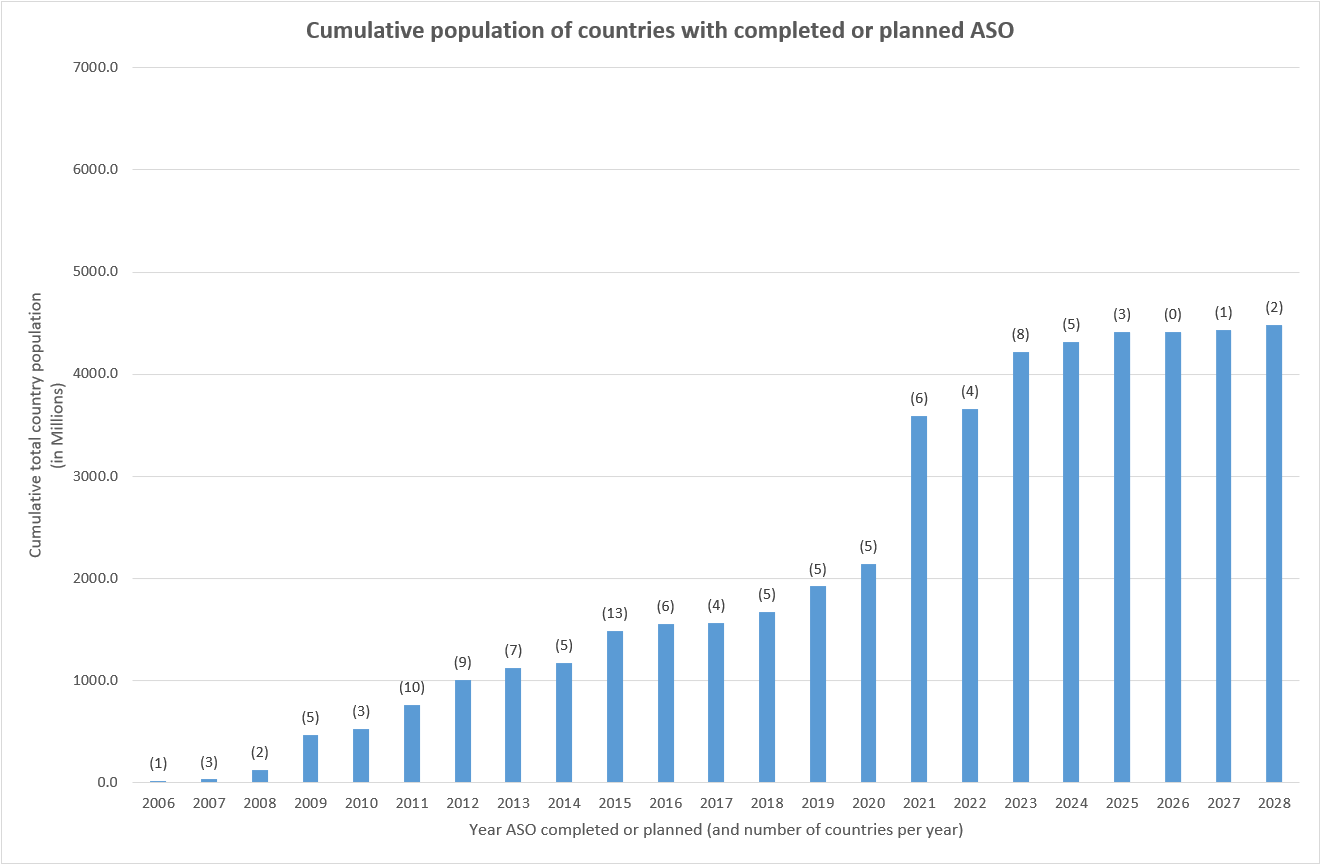 |
The DVB family of standards are predominant globally; in particular DVB-T2 has emerged as the reference technology for DTT.
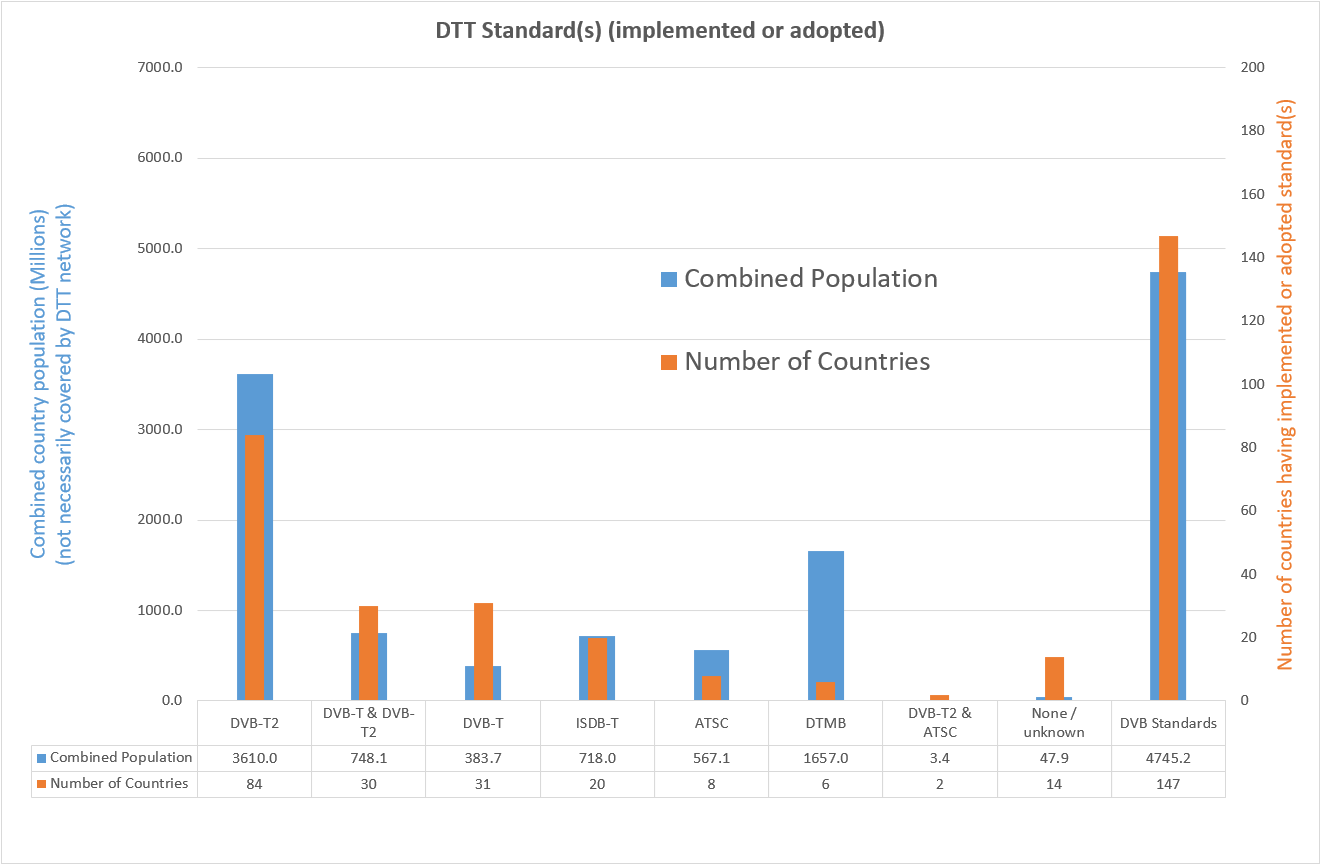 |
DTT coverage is also growing globally, with more than 95% of the population covered in half of the countries for which data is currently available. The box and whisker charts below illustrate how coverage varies within regions and from region to region. (The box shows the second and third quartiles, with the median marked by a line, and the mean by an X. The other dots show outliers for the region in question.)
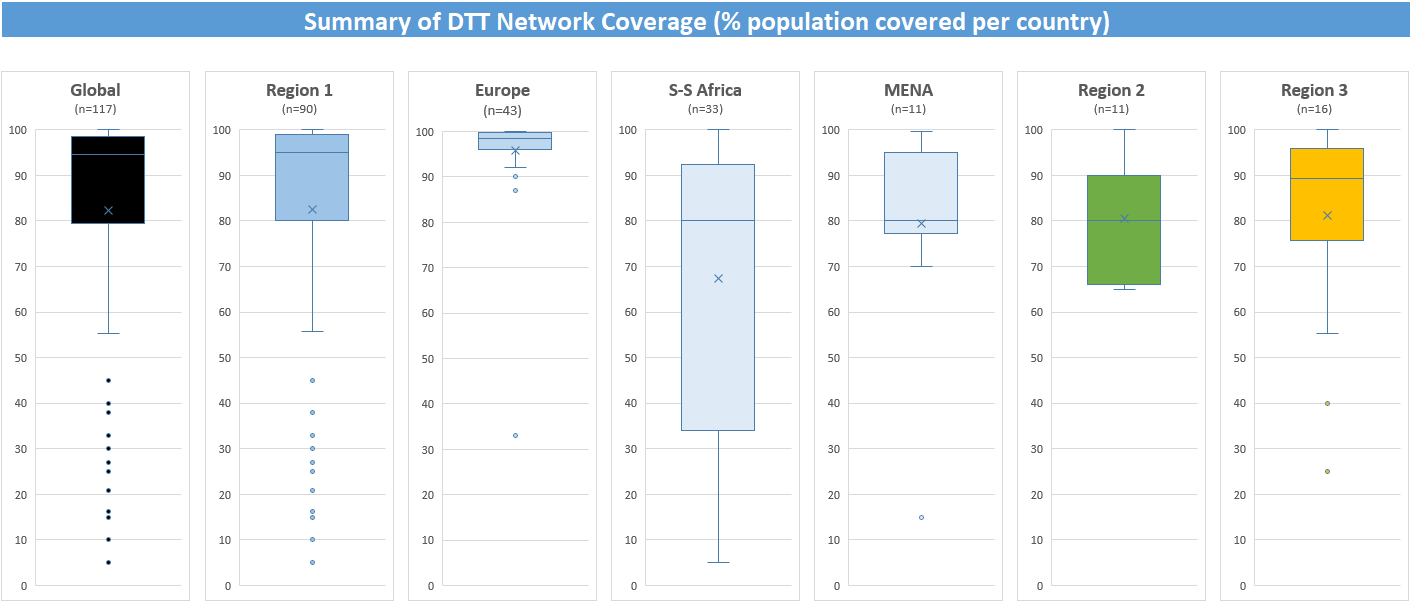 |
While in some countries, up to 50–60, or even more, programmes are available free-to-air on DTT nationally, the range is more typically from 10 to 20 programmes.
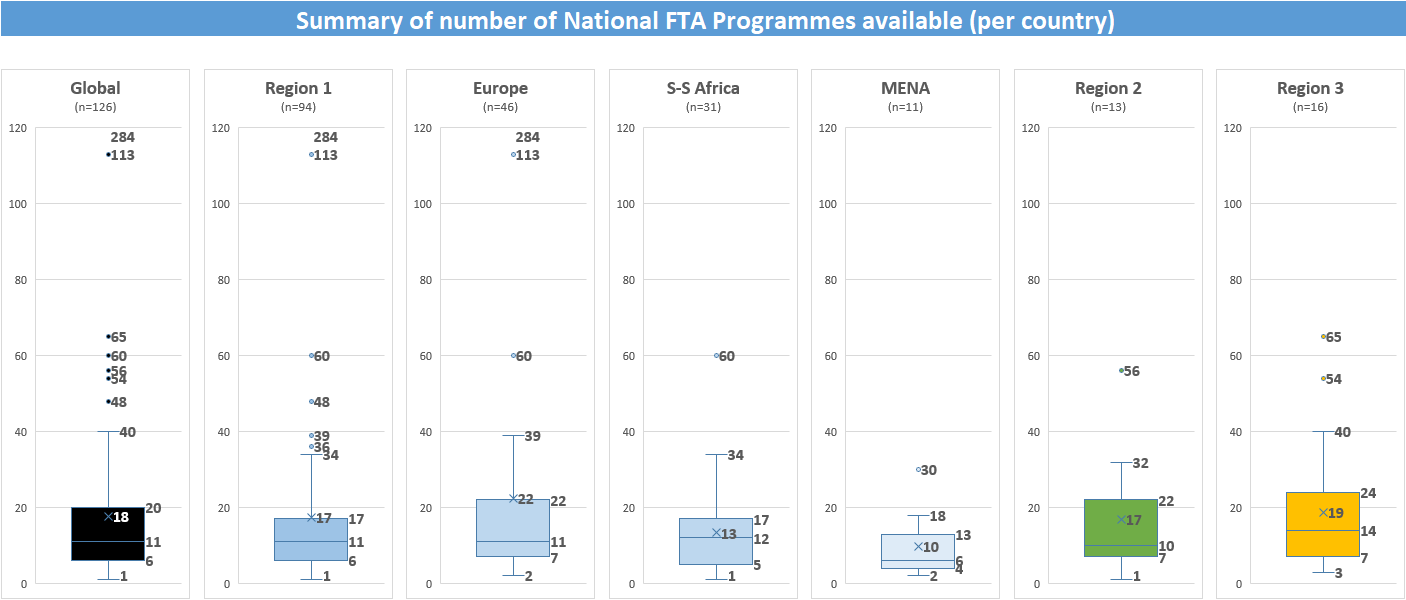 |
PayDTT is a popular and important part of the digital television landscape, especially across Region 1 (with the notable exception, for now, of MENA countries). In countries where payDTT is available, the programme offer is usually extensive, ranging from 30 up to 100 or more programmes.
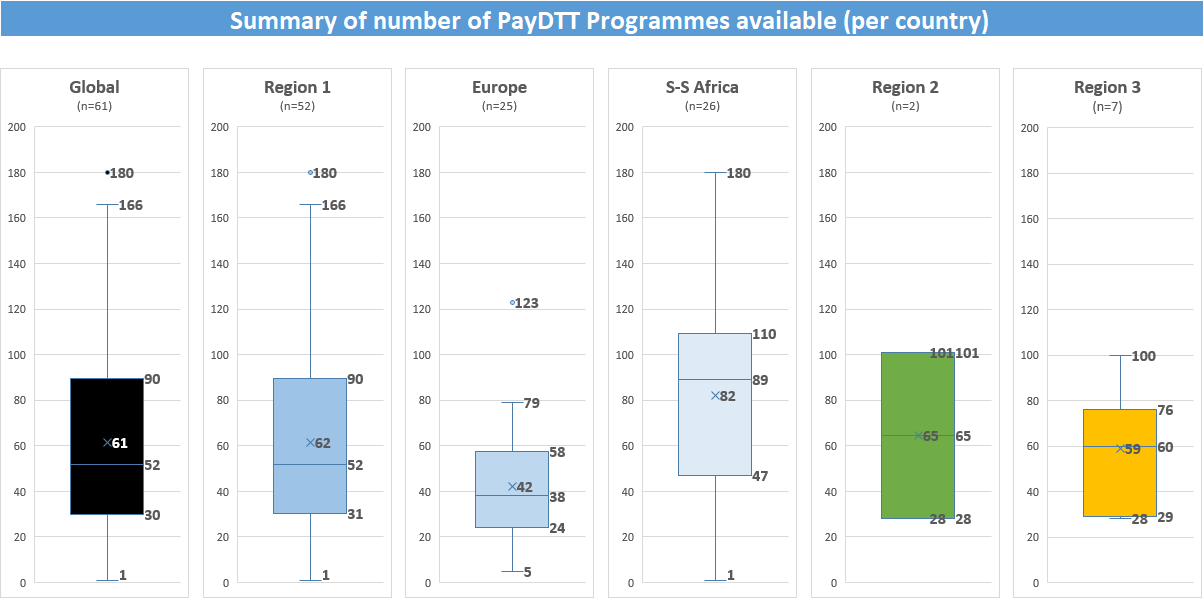 |
WRC-15 Results
The EBU is pleased to report that Region 1, most of Region 3 and South American countries in Region 2 have secured spectrum to facilitate investments that will stabilize Digital Terrestrial Television (DTT) well into the 2020s. A small number of countries in North America (Canada, USA, Mexico, Colombia, and some Caribbean islands), Asia (Bangladesh) and Oceania (New Zealand, and some Pacific Islands) have allocated a portion (614 – 698 MHz), or the whole (470 – 698 MHz) of the UHF band to mobile broadband. Read our WRC-15 Results Fact Sheet to find out more.
